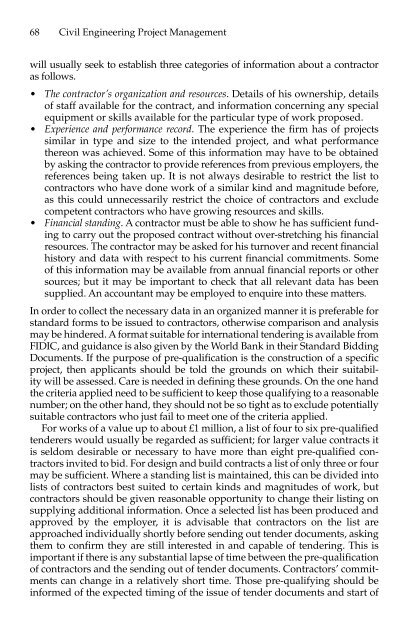Civil Engineering Project Management (4th Edition)
Create successful ePaper yourself
Turn your PDF publications into a flip-book with our unique Google optimized e-Paper software.
68 <strong>Civil</strong> <strong>Engineering</strong> <strong>Project</strong> <strong>Management</strong><br />
will usually seek to establish three categories of information about a contractor<br />
as follows.<br />
• The contractor’s organization and resources. Details of his ownership, details<br />
of staff available for the contract, and information concerning any special<br />
equipment or skills available for the particular type of work proposed.<br />
• Experience and performance record. The experience the firm has of projects<br />
similar in type and size to the intended project, and what performance<br />
thereon was achieved. Some of this information may have to be obtained<br />
by asking the contractor to provide references from previous employers, the<br />
references being taken up. It is not always desirable to restrict the list to<br />
contractors who have done work of a similar kind and magnitude before,<br />
as this could unnecessarily restrict the choice of contractors and exclude<br />
competent contractors who have growing resources and skills.<br />
• Financial standing. A contractor must be able to show he has sufficient funding<br />
to carry out the proposed contract without over-stretching his financial<br />
resources. The contractor may be asked for his turnover and recent financial<br />
history and data with respect to his current financial commitments. Some<br />
of this information may be available from annual financial reports or other<br />
sources; but it may be important to check that all relevant data has been<br />
supplied. An accountant may be employed to enquire into these matters.<br />
In order to collect the necessary data in an organized manner it is preferable for<br />
standard forms to be issued to contractors, otherwise comparison and analysis<br />
may be hindered. A format suitable for international tendering is available from<br />
FIDIC, and guidance is also given by the World Bank in their Standard Bidding<br />
Documents. If the purpose of pre-qualification is the construction of a specific<br />
project, then applicants should be told the grounds on which their suitability<br />
will be assessed. Care is needed in defining these grounds. On the one hand<br />
the criteria applied need to be sufficient to keep those qualifying to a reasonable<br />
number; on the other hand, they should not be so tight as to exclude potentially<br />
suitable contractors who just fail to meet one of the criteria applied.<br />
For works of a value up to about £1 million, a list of four to six pre-qualified<br />
tenderers would usually be regarded as sufficient; for larger value contracts it<br />
is seldom desirable or necessary to have more than eight pre-qualified contractors<br />
invited to bid. For design and build contracts a list of only three or four<br />
may be sufficient. Where a standing list is maintained, this can be divided into<br />
lists of contractors best suited to certain kinds and magnitudes of work, but<br />
contractors should be given reasonable opportunity to change their listing on<br />
supplying additional information. Once a selected list has been produced and<br />
approved by the employer, it is advisable that contractors on the list are<br />
approached individually shortly before sending out tender documents, asking<br />
them to confirm they are still interested in and capable of tendering. This is<br />
important if there is any substantial lapse of time between the pre-qualification<br />
of contractors and the sending out of tender documents. Contractors’ commitments<br />
can change in a relatively short time. Those pre-qualifying should be<br />
informed of the expected timing of the issue of tender documents and start of


















